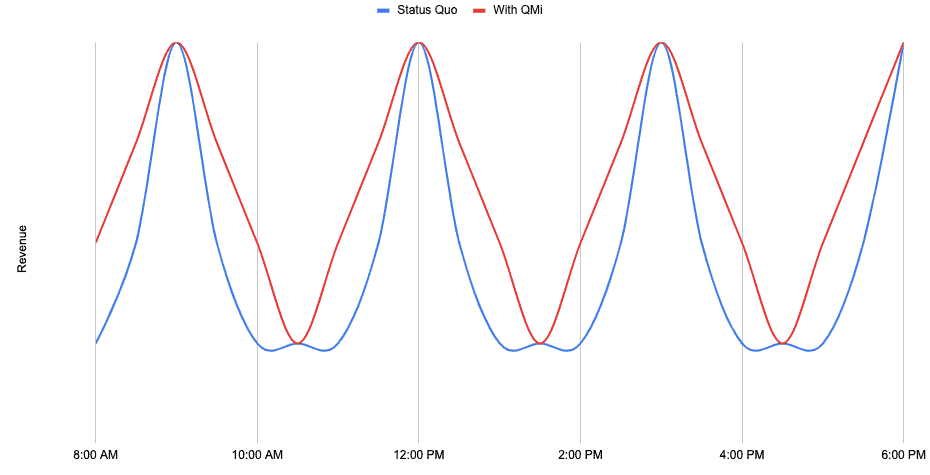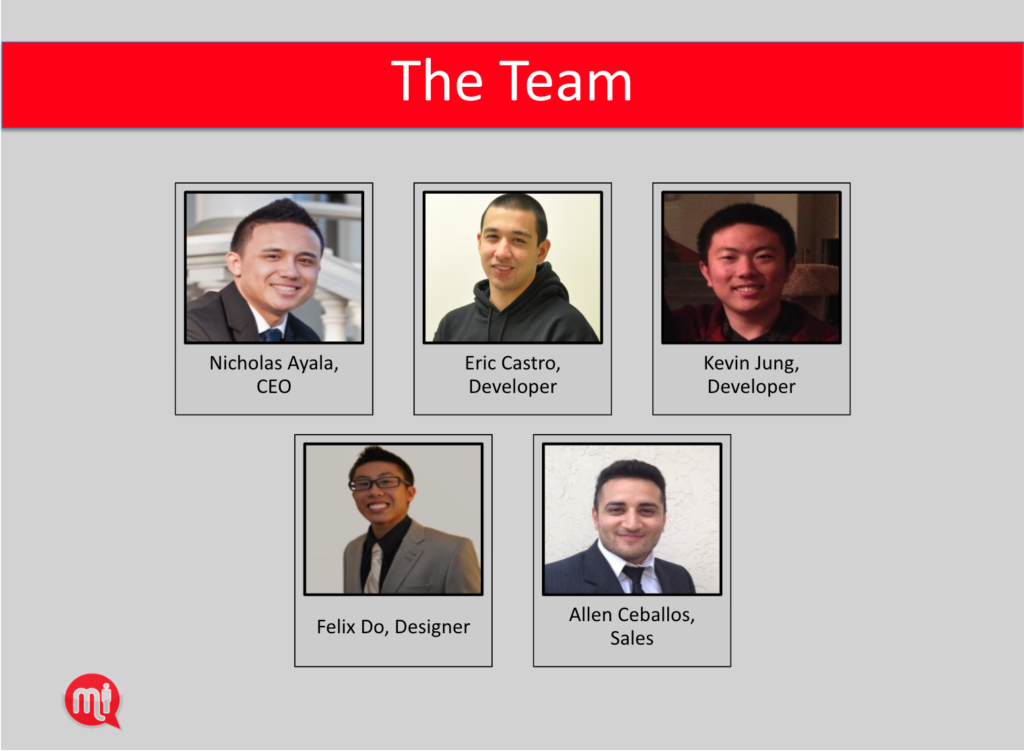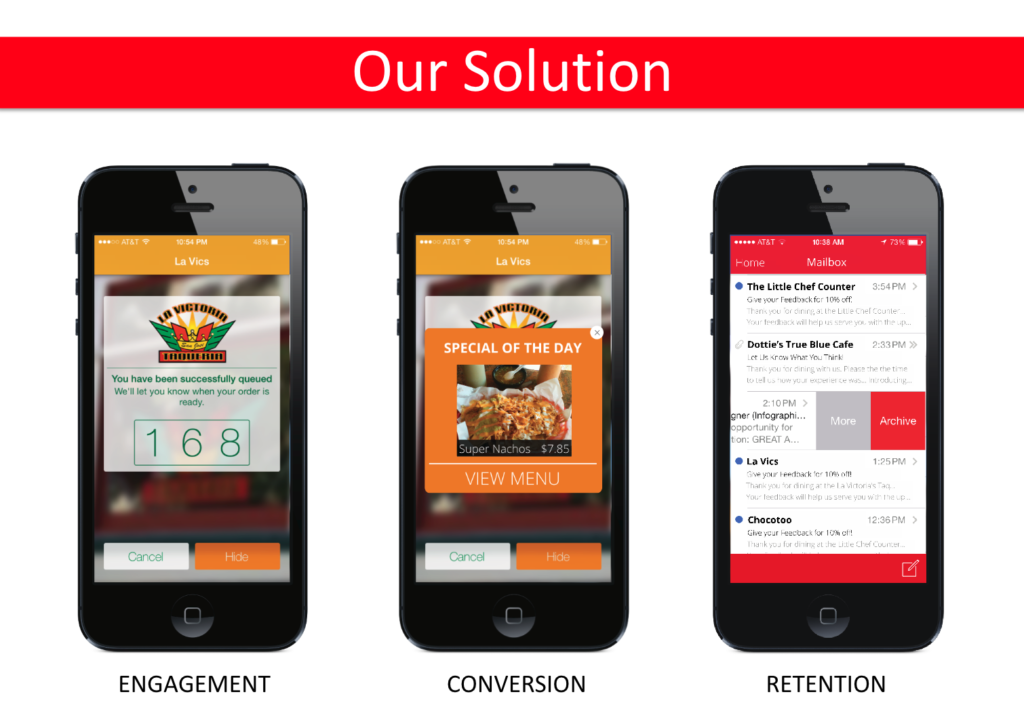QMi Systems [Founder] – Increasing University Food Service Revenue through Pre-orders.

2013 – 2014 (San Jose, CA) – While attending San Jose State University (SJSU), I had the opportunity to be exposed to early-stage startups from Milo (Jack Abraham) to Y Combinator (Harj Taggar). A lot of these opportunities are thanks to Steve Bennett, who was a SJSU professor, Angel Investor, and one of our student organization advisors.
The inception of the first startup that I was a part of was after participating in an overnight hack-a-thon with a small team of friends. From what started as building a small MVP utilizing NFC tags eventually became a 2-year journey building QMi Systems Inc (AngelList, F6S).
Summary
QMi (pronounced “queue me”) is mobile application for universities and quick-service restaurants that enables merchants the ability to accept, process, and manage pre-orders prior to their guests’ arrival. Our initial partnership would have been with SJSU Spartan Shops, who operated the 13+ food service venues on the San Jose State University campus.
At the time, there were two other services that were focused on this industry: Tapingo and OrderAhead. Tapingo was also primarily focused on college and university food management services, while OrderAhead was partnering with local chains like Philz Coffee.
Customer Challenges & Opportunity
Quick-service restaurants (QSR) on college and university campuses face a unique challenge where their captive customer-base will purchase from their food outlets during class passing periods. While most QSR outlets are focused on the lunch or dinner rush, on-campus outlets have usually a 20-minute opportunity every 90-120 minutes to receive and fulfill orders before there is another lull in traffic when most students are in class. This results in any given 8-hour weekday, there are roughly 1.5 hours of peak revenue generating time.
Enabling QSR outlets to accept and begin to fulfill orders before a passing period begins. This will expand the window of opportunity resulting in an increase in overall revenue. Below is an example of the revenue and customer demand before and after the use of QMi.

Founding Team
Our team consisted of five team members that each had a specific area of focus. We were all sophomore to juniors at San Jose State University with backgrounds across engineering, business, and design. While working together on QMi, we were also heavily involved on-campus holding positions as Resident Advisors, Associated Student Government, and various departments on-campus.

Customer Discovery
To determine our founding team’s competitive advantage and ideal customer profile, I facilitated over 30+ client interviews with various QSR professionals from the General Managers of Olive Garden and Cheesecake Factory to Food Service Directors with Aramark. This phase was essential when determining what our potential clients prioritize, problems they are experiencing, and how our team can provide the most significant value.
Since the founding team had so much experience navigating the university landscape, we found that we were able to leverage introductions to professionals located at multiple colleges and universities within California and Nevada. With these early signals, we doubled-downed on the University market.
There were two priorities that we found University-focused QSR outlets cared about the most:
- Increasing Revenues
- Reducing operational and training complexity with a high-turnover staff
Product Features
For a QSR outlet to successfully receive and fulfill a customer’s mobile order, there are a number of components that will need to work in harmony for a successful, delightful customer experience.
Customer-facing Application – Order placement and Queue Notification
The initial QMi experience began on the mobile device of the customer. They needed to have a seamless experience through the following user journey:
- Find their desired restaurant
- Order & Pay
- Receive confirmation of their order
We categorized the experience across three main phases: Engagement, Conversion, and Retention.

Restaurant-facing Application – Order and Queue Management
Restaurants needed the ability to receive and manage orders. At the time, many were operating on older personal computers or paper ticketing systems. To reduce the initial barrier to entry, we would provide refurbished iPads to early adopters. These restaurants will be able to access, respond, and fulfill the mobile orders.
Some of the other things that we had to overcome was that not all restaurants had WiFi access, these sort of infrastructure limitations created additional complexities to overcome during the sales and implementation phases.
Funding
We did not raise any outside funding for this venture.
Go-to-Market (GTM) Difficulties
There were three barriers that we had to overcome getting our product to market.
1. Overcoming restaurant operational complexity
There were many concerns from our initial partners with how to operationalize the QMi platform. Some of the initial questions included:
- How would our team fulfill the orders during normal peak times?
- What if the orders overwhelm our staff?
- How does this impact our staffing requirements?
- What are the equipment costs?
- How do we train our staff?
- How do we get initial users to use this?
With any new solution, there are many concerns that a restaurant could have especially if there is a risk of a misstep reducing their revenue. We had to work with the teams on defining each concern, and documenting how each step in the process will go-live. There were many questions we didn’t have concrete answers for since we hadn’t seen it before. To help reduce some of the initial concerns, we had to work extremely closely with key stakeholders to make sure we could quickly resolve any issues.
2. Creating a viral end-customer acquisition loop
Other consumer-based companies were using referral systems with monetary incentives similar to “Receive $5 for every friend that uses your link.” A referral system like this can significantly increase customer acquisition costs (CAC) and is not feasible without the company being able to have the financial resources to cold-start this flywheel.
Working closely with our initial partners, we found an incentive that had a perceived value higher than it’s actual costs: fountain beverages.
We were able to create a referral incentive where an end-customer could “Receive a free fountain drink (value $2.50) for each person that uses their link.” The actual cost to a QSR outlet was about $0.08 per drink – which our partner agreed to invest towards user adoption.
The last hurdle was identifying how to shift the culture within the University to adopt our solution. We found launching during New Student Orientation would be the ideal time. It’s a sizable cohort of the University that is in a time within their collegiate journey to trying something new, and can eventually become accustomed to using the new service.
3. Company and product confidence
Our team was young, and this was a large concern that was consistently expressed. At the end of the day, we were each between the ages of 18 – 20 years old. We had to work extremely hard to find someone that believed in our vision as much as we did, and develop a plan to work with them to reduce as much risk to their business as possible. Our team knew it was essential to have a few ‘wins’ to build initial momentum and credibility.
Key Takeaways
Bootstrapped as a Creativity Forcing-function
Having limited financial resources created a constraint that helped us keep focus on the top priorities across the organization. Our go-to-market strategy was the result of not having the financial means to subsidize initial user growth and customer adoption. We had to closely work with our restaurant partners to truly identify their priorities while keeping in mind what customers also were incentivized by.
Learning: Lack of funding can be an advantage to finding creative solutions.
Small teams move faster
Having a team of five quickly came with complexities. It was difficult finding a consistent time all five team members could meet, sync, and strategize the top priorities. In the event that a team member was absent, roadblocks may have emerged and stall other team members from completing their tasks.
Learning: Keeping a team as small as possible for as long as possible is essential to move quickly in the early days.
Customer acquisition & commitment
As one of the leads responsible for acquiring customers, I learned the difference between being busy and making significant progress for the business. I had met with many stakeholders across multiple businesses, but was unable to acquire significant commitments – either through fully committed contracts or letters of intent.
Learning: Nothing is concrete until there is a contract in place.
Many of these learnings I would find helpful when starting Connect’d. You can read more about that venture here.
Shutting Down QMi Systems Inc.
After two years of working on QMi Systems, the team was nearing graduation and needed to make a pivotal decision. Does the team focus on QMi Systems full-time or should we turn our focus on interviewing for our first post-graduate jobs?
By this time, we were unable to sign any concrete letters of intent and our initial product was still in development. We estimated that we had another 3-6 months before a viable product would be ready.
As a majority of the team did not have the financial ability, nor funding available, to pursue QMi full-time after graduation, we all made the hard choice to shut down QMi and begin our careers within other established corporations.

![Clubhouse [Early Employee] – Learnings During High-Growth & Next Career Chapter with Fair Square Medicare](https://legacy.nicholasayala.com/wp-content/uploads/2023/06/Goodbye-Clubhouse-Hello-FSM-3-768x432.png)
![Connect’d [Founder] – A social contacts app.](https://legacy.nicholasayala.com/wp-content/uploads/2022/08/Connectd-Banner-e1687997320283-768x559.png)